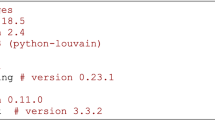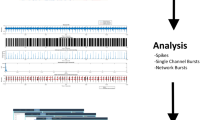Abstract
A growing area in neurosciences is focused on the modelling and analysis of connectome, i.e. the set of connections among the constitutive element of the brain. Among the representations, the use of graph theory is largely used. Such discipline uses neuroimaging techniques to derive the connections among the elements. Images represent the anatomical regions of the brain and images are usually compared to an atlas to identify them, and this process is usually referred to as parcellation. It fails in the presence of disease and for brains of children. Consequently, atlas-free random brain parcellation has been proposed that is based to divide the image into regions and to model each region as a node. Then connections among regions are represented by (un)weighted edges. To improve parcellation, a set of images is taken from the same subject, and then the resulting brain is derived by comparing resulting graphs of each image. Therefore, the question of comparison of the structure of networks arises using network alignment (NA) algorithms. In this paper, we first defined the NA problem formally, then we applied three existing states of the art of multiple alignment algorithms (MNA) on diffusion MRI-derived brain networks, and we compared the performances. Our findings show that MNA algorithms may be applied.

Similar content being viewed by others
References
Bargmann CI, Marder E (2013) From the connectome to brain function. Nat Methods 10(6):483–490
Brugere I, Gallagher B, Berger-Wolf TY (2018) Network structure inference, a survey: motivations, methods, and applications. ACM Comput Surv 51(2):24
Bullmore E, Sporns O (2009) Complex brain networks: graph theoretical analysis of structural and functional systems. Nat Rev Neurosci 10(3):186–198
Ciriello G, Mina M, Guzzi PH, Cannataro M, Guerra C (2012) AlignNemo: a local network alignment method to integrate homology and topology. PLoS One 7(6):e38107
Fornito A, Zalesky A, Breakspear M (2013) Graph analysis of the human connectome: promise, progress, and pitfalls. Neuroimage 80:426–444
Fornito A, Zalesky A, Bullmore ET (2010) Network scaling effects in graph analytic studies of human resting-state FMRI data. Resting State Brain Act Implic Syst Neurosci 40:22
Geyer S, Weiss M, Reimann K, Lohmann G, Turner R (2011) Microstructural parcellation of the human cerebral cortex—from brodmann’s post-mortem map to in vivo mapping with high-field magnetic resonance imaging. Front Human Neurosci 5:19
Guzzi PH, Milenković T (2017) Survey of local and global biological network alignment: the need to reconcile the two sides of the same coin. Brief Bioinform 19:472–481 (bbw132)
Ibragimov R, Malek M, Guo J, Baumbach J (2013) GEDEVO: an evolutionary graph edit distance algorithm for biological network alignment. In: OASIcs-OpenAccess series in informatics, vol 34. Schloss Dagstuhl–Leibniz-Zentrum fuer Informatik
Ibragimov R, Malek M, Baumbach J, Guo J (2014) Multiple graph edit distance: simultaneous topological alignment of multiple protein-protein interaction networks with an evolutionary algorithm. In: Proceedings of the 2014 annual conference on genetic and evolutionary computation. ACM, pp 277–284
Kiani R, Cueva CJ, Reppas JB, Peixoto D, Ryu SI, Newsome WT (2015) Natural grouping of neural responses reveals spatially segregated clusters in prearcuate cortex. Neuron 85(6):1359–1373
Liao C-S, Kanghao L, Baym M, Singh R, Berger B (2009) Isorankn: spectral methods for global alignment of multiple protein networks. Bioinformatics 25(12):i253–i258
Mamano N, Hayes WB (2017) SANA: simulated annealing far outperforms many other search algorithms for biological network alignment. Bioinformatics 33:2156–2164 (btx090)
Meng L, Striegel A, Milenkovic T (2015) Local versus global biological network alignment. arXiv:1509.08524 (preprint)
Milano M, Guzzi PH, Tymofieva O, Xu D, Hess C, Veltri P, Cannataro M (2017) An extensive assessment of network alignment algorithms for comparison of brain connectomes. BMC Bioinform 18(6):235
Milano M, Tymofiyeva O, Xu D, Hess C, Cannataro M, Guzzi PH (2016) Using network alignment for analysis of connectomes: Experiences from a clinical dataset. In: Proceedings of the 7th ACM international conference on bioinformatics, computational biology, and health informatics. ACM, pp 649–656
Mina M, Guzzi PH (2014) Improving the robustness of local network alignment: design and extensive assessmentof a markov clustering-based approach. Comput Biol Bioinform IEEE/ACM Trans 11(3):561–572
Mina M, Guzzi PH (2012) AlignMCL: comparative analysis of protein interaction networks through Markov clustering. In: 2012 IEEE International Conference on bioinformatics and biomedicine workshops (BIBMW). IEEE, pp 174–181
Neyshabur B, Khadem A, Hashemifar S, Arab SS (2013) NETAL: a new graph-based method for global alignment of protein–protein interaction networks. Bioinformatics 29(13):1654–1662
Patro R, Kingsford C (2012) Global network alignment using multiscale spectral signatures. Bioinformatics 28(23):3105–3114
Saraph V, Milenković T (2014) MAGNA: maximizing accuracy in global network alignment. Bioinformatics 30(20):2931–2940
Shenoy-Bhangle A, Baliyan V, Kordbacheh H, Guimaraes AR, Kambadakone A (2017) Diffusion weighted magnetic resonance imaging of liver: principles, clinical applications and recent updates. World J Hepatol 9(26):1081
Sporns O (2010) Networks of the brain. MIT Press, Cambridge
Sporns O, Tononi G, Kötter R (2005) The human connectome: a structural description of the human brain. PLoS Comput Biol 1(4):e42
Stelzl U, Worm U, Lalowski M, Haenig C, Brembeck FH, Goehler H, Stroedicke M, Zenkner M, Schoenherr A, Koeppen S et al (2005) A human protein-protein interaction network: a resource for annotating the proteome. Cell 122(6):957–968
Sun Y, Crawford J, Tang J, Milenković T (2015) Simultaneous optimization of both node and edge conservation in network alignment via wave. In: International workshop on algorithms in bioinformatics. Springer, New York, pp 16–39
Thirion B, Varoquaux G, Dohmatob E, Poline J-B (2014) Which fMRI clustering gives good brain parcellations? Front Neurosci 8:167
Toga AW, Clark KA, Thompson PM, Shattuck DW, Van Horn JD (2012) Mapping the human connectome. Neurosurgery 71(1):1
Tymofiyeva O, Ziv E, James Barkovich A, Hess CP, Xu D (2014) Brain without anatomy: construction and comparison of fully network-driven structural mri connectomes. PLoS One 9(5):e96196
Vijayan V, Milenkovic T (2016) Multiple network alignment via multimagna++. arXiv:1604.01740 (preprint)
Vijayan V, Milenković T (2018) Multiple network alignment via multimagna++. IEEE/ACM Trans Comput Biol Bioinform 15(5):1669–1682
Xia M, He Y (2011) Magnetic resonance imaging and graph theoretical analysis of complex brain networks in neuropsychiatric disorders. Brain Connect 1(5):349–365
Acknowledgements
PHG,MM and MC have been partially supported by the following research project funded by the Italian Ministry of Education and Research (MIUR): BA2Know-Business Analytics to Know (PON03PE_00001_1). PHG was partially supported by GNCS project INdAM - GNCS Project 2017: Efficient Algorithms and Techniques for the Organization, Management and Analysis of Biological Big Data (Algoritmi e tecniche efficienti per lorganizzazione, la gestione e l’analisi di Big Data in ambito biologico) The authors wish to thank Olga Tymofiyeva for her suggestions to this research activity.
Author information
Authors and Affiliations
Contributions
PHG and MM conceived the main idea of the algorithm and designed the tests. MC supervised the design of the algorithm. PHG and MM designed the functional requirements of the software tool. All authors read and approved the final manuscript.
Corresponding author
Rights and permissions
About this article
Cite this article
Milano, M., Guzzi, P.H. & Cannataro, M. Using multiple network alignment for studying connectomes. Netw Model Anal Health Inform Bioinforma 8, 5 (2019). https://doi.org/10.1007/s13721-019-0182-8
Received:
Revised:
Accepted:
Published:
DOI: https://doi.org/10.1007/s13721-019-0182-8




